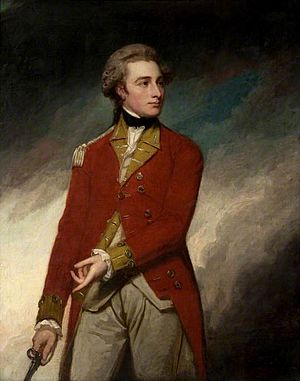Charles Stuart (British Army officer, born 1753) facts for kids
Quick facts for kids
Charles Stuart
|
|
|---|---|

Lieutenant Colonel Sir Charles Stuart by George Romney
|
|
| Born | January 1753 Kenwood House, London, England |
| Died | 25 May 1801 Richmond Park, Surrey, England |
| Allegiance | |
| Service/ |
|
| Rank | Lieutenant-general |
| Battles/wars | French Revolutionary Wars |
| Awards | Knight of the Order of the Bath |
Lieutenant-general Sir Charles Stuart (born January 1753 – died May 25, 1801) was a brave British soldier and nobleman. He was the fourth son of John Stuart, 3rd Earl of Bute, and Mary Wortley Montagu. Charles was born in Kenwood House, a grand home in London.
He had several notable brothers and sisters. His brother John Stuart, 1st Marquess of Bute became a Marquess. Another brother, William Stuart, became an important church leader. His sister Lady Louisa Stuart was a writer. His other sisters married important figures of their time.
Contents
The Life of Sir Charles Stuart
Starting a Military Career
Charles Stuart began his military journey in 1768. He joined the 37th Regiment of Foot as an ensign, which is a junior officer rank. Over the next few years, he quickly moved up the ranks. By 1773, he was a captain in the 35th Foot.
Fighting in America
In October 1773, Charles became a major in the 43rd Regiment of Foot. He then served in the American War of Independence. This was a big conflict where the American colonies fought for their independence from Britain. In 1777, he became a lieutenant-colonel and led the 26th Regiment of Foot.
While visiting England, he married Anne Louisa Bertie in 1778. He briefly returned to America before coming back to London. He often shared his strong opinions on how the army was run. Even so, he was highly respected by Sir Henry Clinton, a top general. Charles had two sons after returning from America:
- Charles Stuart, 1st Baron Stuart de Rothesay (born 1779)
- Captain John James Stuart (born 1782), who died while commanding his ship.
Challenges and New Beginnings
Charles was promoted to colonel in 1782. However, his strong opinions and his father's disagreements with George III meant he didn't get many more military commands for a while. He also served as a Member of Parliament (MP) for Bossiney for most of his life, though he wasn't very interested in politics. In 1792, he inherited the Highcliffe House estate in Hampshire.
When Britain went to war with France, Charles returned to active service. This was during the French Revolutionary Wars.
Leading Troops in Europe
Taking Corsica
On May 23, 1794, Charles Stuart took command of the army in Corsica. He led the successful capture of Calvi. This was the battle where Horatio Nelson, a famous British admiral, lost an eye. For his success, Charles was promoted to lieutenant-general. He also became colonel of the 68th Regiment of Foot.
However, Charles sometimes disagreed strongly with others in charge. He had conflicts with Lord Hood, who led the navy, and with the civilian leader of Corsica, Sir Gilbert Elliot. These disagreements led him to resign in February 1795. He then became colonel of the 26th Regiment of Foot, a position he held for the rest of his life.
Defending Portugal
In January 1797, Charles was sent to Portugal to defend Lisbon. He was very successful in making the troops disciplined and motivated. This force included soldiers from different countries.
Capturing Menorca
In 1798, Charles was sent to attack Menorca (also known as Minorca) with 3,000 soldiers. This mission was strongly supported by Lord St Vincent, another important admiral. Lord St Vincent praised Charles as an excellent general.
Even without heavy siege cannons, Charles managed to trick the Spanish forces into surrendering the island. He did this without any loss of life! For this clever achievement, he was made a Knight of the Bath. From November 1798 to 1800, he served as the British governor of Menorca. In 1799, he helped Admiral Nelson by sending troops to secure Messina against a possible French invasion.
Later Life and Legacy
In April 1800, Charles resigned as governor of Menorca and returned to England. He was offered a very important job as the Commander-in-Chief, Ireland, but he sadly passed away before he could accept it. He died at his home in Richmond Park on May 25, 1801.
Charles Stuart was buried in the family vault at St Peter's Church, Petersham. There are monuments dedicated to him in Westminster Abbey and in St Peter's Church. He was a very capable general and leader. Although he sometimes had strong disagreements with others, his military career was very successful.

